Robert Lea
Wed, December 27, 2023
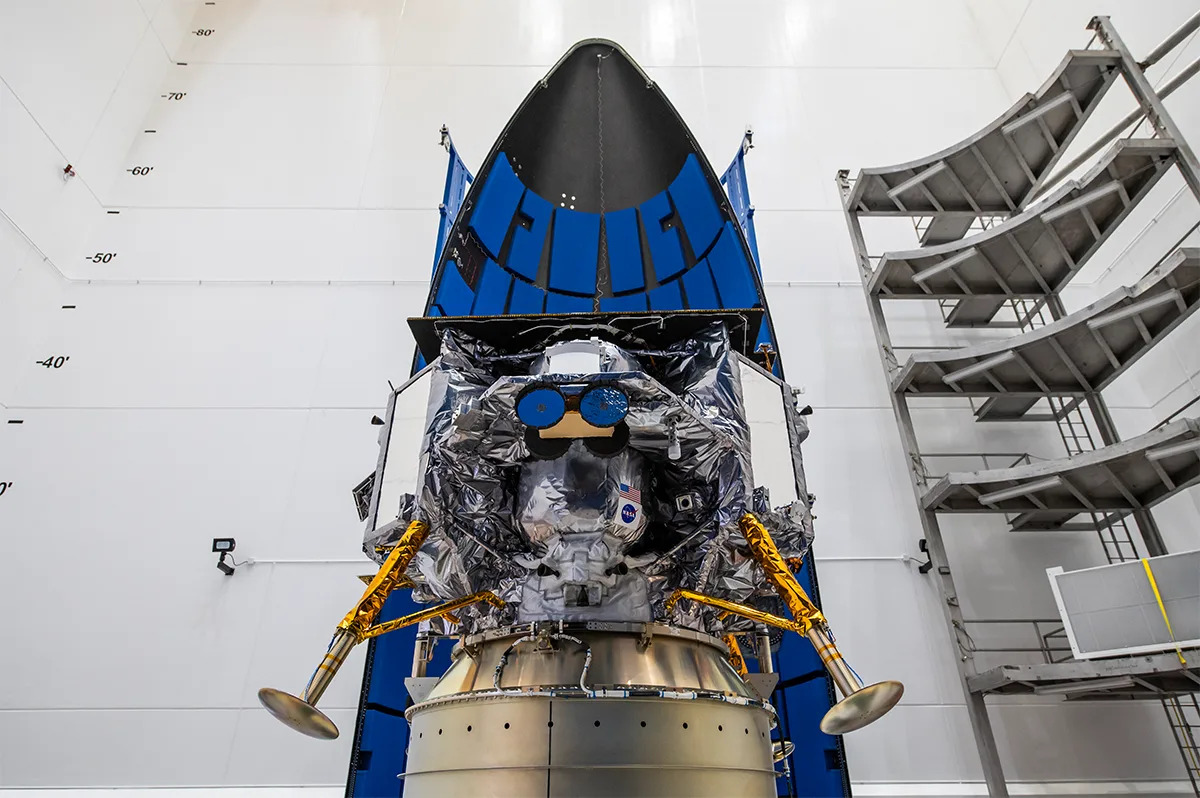
The Peregrine prior to being loaded atop the ULA Vulcan rocket.
The Peregrine lunar lander has completed all its launch milestones and has been stacked atop the Vulcan Centaur rocket that will carry it to space.
The launch of the first United Launch Alliance (ULA) Vulcan Centaur rocket from Cape Canaveral, Florida, is set for Jan. 8, 2024, with Astrobotic's Peregrine lunar lander expected to attempt a landing on the moon on Feb. 23, 2024.
The landing will make history as not only is Peregrine Astrobotic’s first lander mission, but this is also (possibly) set to be the first time a private spacecraft has set down on the moon, pending the progress of other missions as well (such as an Intuitive Machines launch aboard SpaceX set for no earlier than mid-February.)
"If you've been following the lunar industry, you understand landing on the Moon’s surface is incredibly difficult. With that said, our team has continuously surpassed expectations and demonstrated incredible ingenuity during flight reviews, spacecraft testing, and major hardware integrations," Astrobotic CEO John Thornton said in a statement from the company. “We are ready for launch and for landing.”
Related: Japan's SLIM 'moon sniper' lander arrives in lunar orbit for Christmas
Rocket scientist and president of ULA, Tony Bruno, celebrated the final steps toward the launch of the private lunar lander with a stunning time-lapse video shared on his X feed (formerly Twitter) on Dec. 22.
Though Peregrine has come through three weeks of important final checks and fueling needed to be achieved prior to launch, there is a whole new set of milestones for the spacecraft to clear after blast-off.
These will begin shortly after launch when the lander will separate from its Vulcan rocket carrier and will power on, following which it will establish communication with ground control on Earth. This communication will flow through the NASA Deep Space Network system to the Astrobotic mission control center in Pittsburgh, allowing Peregrine's operators to determine its position, orientation, and operating health.
Following this and around 40 minutes after separation, ground control will begin sending commands to the lunar lander's propulsion system. One of the first series of commands will tell the thrusters to reorientate Peregrine so its energy-harvesting solar panels are directed toward the sun, allowing them to start powering up the spacecraft's battery.
The team at Astrobotic will then perform maneuvers in Earth's orbit that prepare Peregrine for insertion into an orbit around the moon. The spacecraft will maintain a stable lunar orbit, performing system checks before heading for a historic touchdown at the end of February.
Related
— How NASA’s VIPER rover could revolutionize moon exploration with AI mission
— Will Artemis 2 launch to the moon in 2024? NASA has a lot of work ahead
—55 years after Apollo 8’s Christmas at the moon, a new Artemis crew readies for launch (exclusive)
"I have high praise for the professionalism, dedication, and technical expertise demonstrated by the Astrobotic team throughout the complex multi-year Peregrine development program," Peregrine Mission One Director Sharad Bhaskara said in the statement. "Evolving Peregrine from a paper concept to a fully tested spacecraft ready for launch is a remarkable achievement for a small business."
10 exhilarating spaceflight missions to watch in 2024
Samantha Mathewson
Thu, December 28, 2023
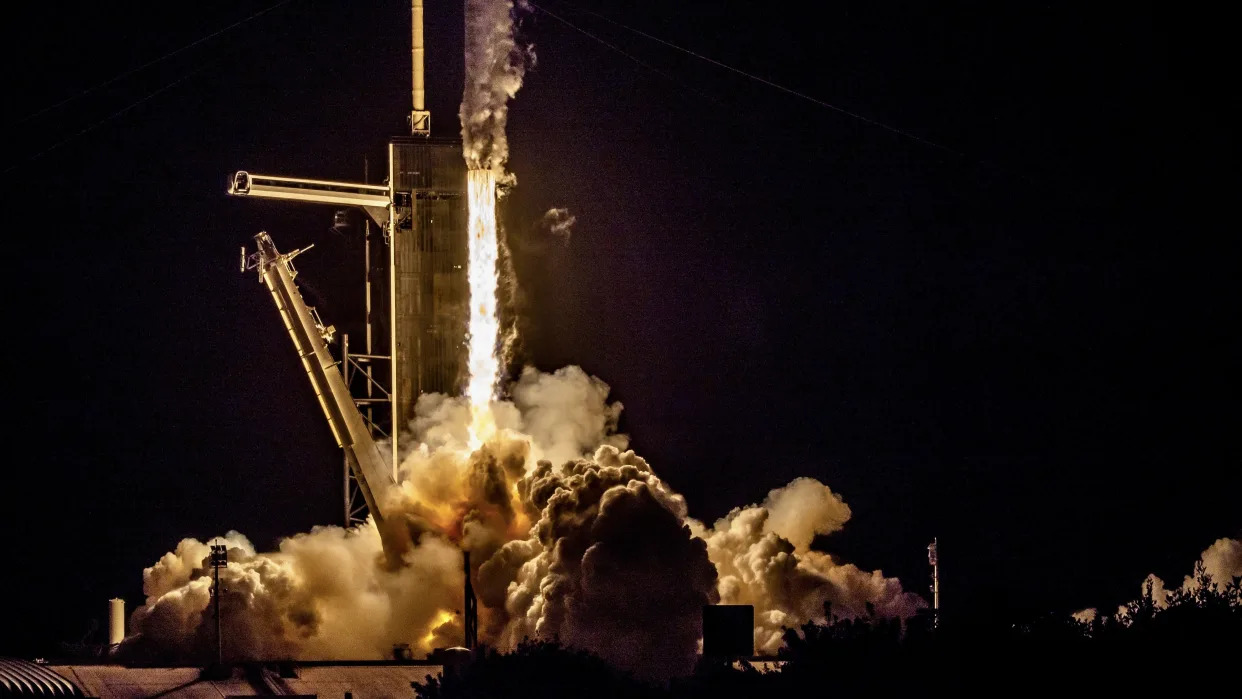
In the dark of night, a rocket blasts fire from its engines, sending plumes of smoke jetting out as it climbs the launch tower out of frame.
Next year is bound to be packed with exciting spaceflight missions, from long-awaited rocket launches to incredible moon missions — including some that'll dabble in lunar landers and crewed flights — a new Jupiter probe headed to the beyond and even a demonstration flight of a new International Space Station resupply spacecraft. With that in mind, here are a few particular missions we're looking forward to in 2024.
1. Moon Missions
The Japanese Aerospace Exploration Agency (JAXA) launched its Smart Lander for Investigating Moon (SLIM) mission on Sept. 6. Currently en route to the lunar surface, the spacecraft is scheduled for a Jan. 19 landing inside the moon's Shioli Crater. The SLIM mission aims to demonstrate a landing with a precision of less than 330 feet (100 meters) from the target. If successful, the spacecraft’s touchdown will mark the first-ever soft lunar landing for a Japanese spacecraft, and make Japan the fifth country to soft-land on the moon after the Soviet Union, the United States, China and India.
A company named Astrobotic Technology is also targeting the moon next year, with plans to launch its first lunar lander on Jan. 8, followed by a Feb. 23 landing attempt. The Peregrine lunar lander will carry 20 commercial and government payloads, including a small lunar rover developed by Carnegie Mellon University scientists and a set of smaller rovers provided by the Mexican Space Agency.
The launch window for Intuitive Machines' IM-1 lunar mission opens mid-February. This spacecraft aims to touch down near the south pole of the moon, requiring specific lighting conditions that are only available in the region for a handful of days each month. In partnership with SpaceX, the IM-1 mission will be the company's first attempted lunar landing as part of NASA's Commercial Lunar Payload Services (CLPS) initiative, which will later support the space agency’s Artemis program and plans to establish a sustainable human presence on the moon.
China’s Chang'e 6 mission is expected to launch in 2024, representing the country's second sample return mission. The lander will collect material from the South Pole-Aitken (SPA) basin on the far side of the moon. This mission follows the successful Chang'e 5 lunar sample return mission, which launched in 2020.
2. Artemis 2
If all goes to plan, humans are also going to be headed back to the moon in 2024. NASA's Artemis 2 lunar mission will send the first astronauts around the moon in nearly 50 years. Slated to launch no earlier than November 2024, the eight-day mission will fly four astronauts around the moon aboard an Orion spacecraft using a Space Launch System (SLS) rocket.
Venturing some 6,400 miles (10,300 kilometers) beyond the far side of the moon, the Artemis 2 mission represents the first crewed mission beyond low Earth orbit since Apollo 17 in 1972. The Artemis 2 crew includes NASA commander Reid Wiseman, NASA pilot Victor Glover (the first person of color to leave low Earth orbit), NASA mission specialist Christina Koch (the first woman to make the trip) and Canadian Space Agency astronaut Jeremy Hansen (the first non-American to make the trip).
3. Vulcan Centaur Rocket
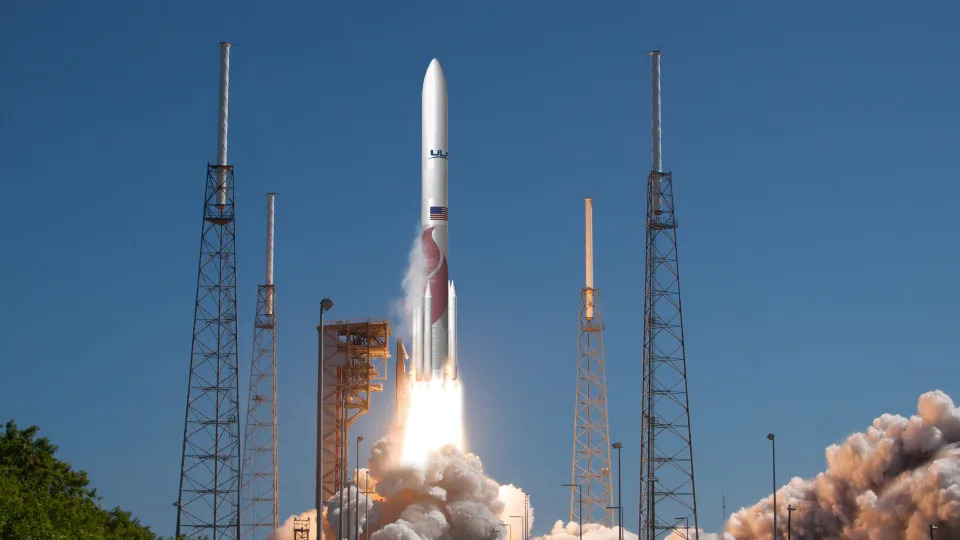
Vulcan Centaur rocket launching
After multiple delays over five years, the first flight of the United Launch Alliance’s (ULA) Vulcan Centaur rocket is scheduled for Jan. 8. The rocket has been fully assembled at Cape Canaveral, Florida, in preparation for its inaugural flight, which will carry multiple payloads, including Astrobotic Technology's aforementioned Peregrine lunar lander.
Standing 202 feet (62 meters) tall, Vulcan Centaur is the successor to the ULA's Atlas V and Delta IV rockets with an advanced capability to carry a payload of up to 7.7 tons to geostationary orbit. For its Jan. 8 launch, the rocket will also carry a payload from the space memorial company Celestis, which includes the remains of cast members of the original "Star Trek" television series — Nichelle Nichols, DeForest Kelley and James Doohan — as well as series creator Gene Roddenberry, his wife Majel Barrett Roddenberry and recurring series actor Majel Barrett Roddenberry.
4. Sierra Space Dream Chaser
NASA and Sierra Space expect to launch a demonstration mission of the company's Dream Chaser spacecraft in 2024 using the ULA Vulcan Centaur rocket. Dream Chaser is a private reusable spacecraft designed to send cargo and astronauts to low Earth orbit. The first uncrewed flight of the shuttle-shaped spaceplane will be to the International Space Station. Dream Chaser is scheduled to deliver over 7,800 pounds of cargo for this demonstration mission, but is capable of carrying upwards of 11,500 pounds. It can also ferry experiment samples, trash and other cargo from the orbiting lab back to Earth. If all goes well, Dream Chaser will be a key part of NASA's commercial resupply services program.
5. Polaris Dawn
The Polaris Dawn mission — a private human spaceflight mission operated by SpaceX on behalf of Jared Isaacman, the founder of payment provider Shift4 — is scheduled to launch no earlier than April 2024. Isaacman and three others will spend several days in low Earth orbit on a Crew Dragon spacecraft.
Polaris Dawn is the first of three planned missions in the Polaris program, which aims to conduct scientific experiments, raise money for St. Jude's Children's Research Hospital in Memphis, Tennessee, and to perform the first commercial spacewalk using SpaceX-designed spacesuits. Commanded by Isaacman, the Polaris Dawn crew includes one veteran astronaut and businessperson, two SpaceX personnel experienced in crewed and uncrewed launches and mission operations, and a former combat pilot.
6. Starship IFT-3
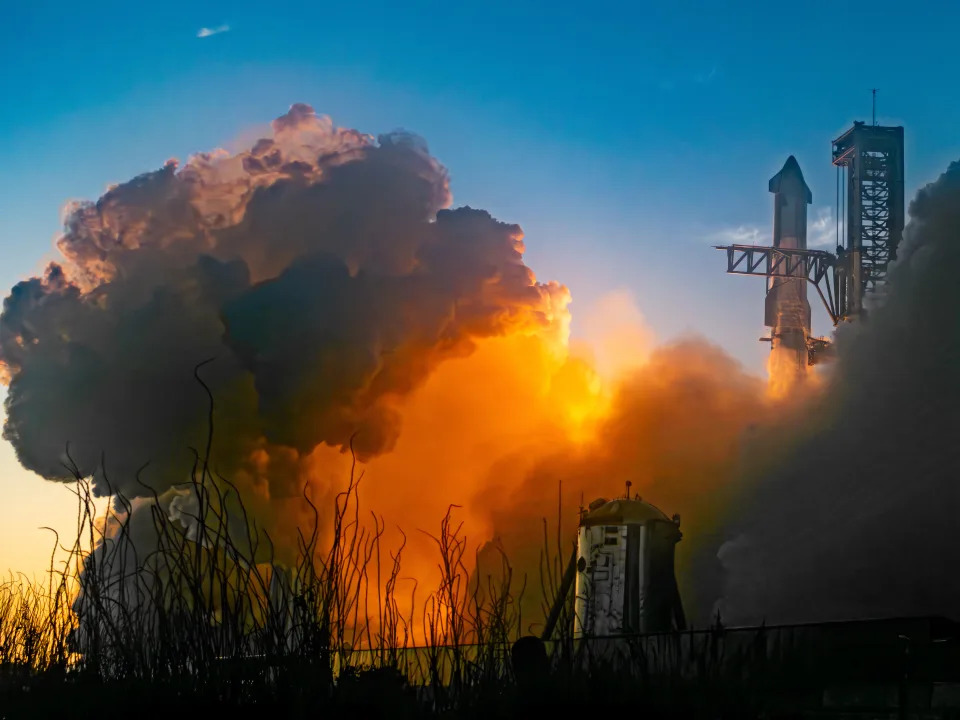
a giant rocket lifts from its launchpad, smoldering plumes of smoke erupt around
SpaceX's Starship rocket is gearing up for its third flight, IFT-3, within the first quarter of 2024. The IFT-3 of Ship 28 and Booster 10 aims to validate critical technologies essential for future lunar and interplanetary missions. This mission follows the company's second flight test (IFT-2) on November 18, 2023, which demonstrated successful hot staging but experienced telemetry loss after eight minutes of flight. Each flight test provides valuable data, from which the company can learn and adapt future attempts. That said, a critical test planned for IFT-3 is the propellant transfer utilizing two different tanks within Starship.
7. Ariane 6
The European Space Agency (ESA) aims to launch its Ariane 6 rocket in the middle of 2024. Recent tests were completed on Dec. 7 and Dec. 15, which entailed launch operation preparedness for the rocket's inaugural flight. While the Dec. 7 test of the rocket's upper stage was aborted shortly after what seemed to be a normal liftoff, the Dec. 15 test of the rocket's core and upper stages went smoothly.
The practice countdown ran as planned, concluding with a four-second firing of the core stage's Vulcain 2.1 engine. The cause of the abort during the Dec. 7 test is still under investigation, with an update expected to arrive mid-January. However, ESA does not expect this will impact the Ariane 6 schedule, with additional tests of the rocket's launch system slated for early 2024.
8. New Glenn’s ESCAPAGE Launch
The first launch of Blue Origin's New Glenn rocket appears promising for 2024 after a long history of delays since 2020. The two-stage heavy-lift rocket stands more than 320 feet (98 meters) tall, with the capability to haul nearly 100,000 pounds (45 metric tons) of payload into low-Earth orbit. New Glenn is designed to be a reusable launch vehicle for up to 25 missions. Slated for its inaugural flight is NASA's Escape and Plasma Acceleration and Dynamics Explorers (ESCAPADE) mission to study Mars' magnetosphere.
This ESCAPADE mission consists of two identical small spacecraft that will collect two-point observations simultaneously to better understand how energy and plasma enter and leave the magnetosphere, and how they interact with solar wind. It will take roughly 11 months for the ESCAPADE probes to arrive at Mars post-launch.
9. Europa Clipper
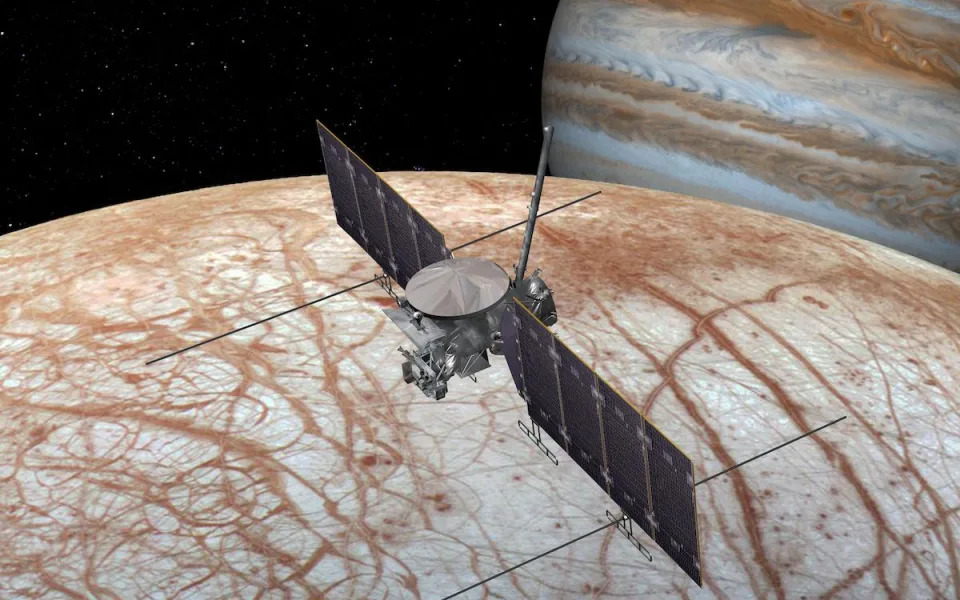
Artist's rendering of the Europa Clipper spacecraft above the surface of Europa.
NASA plans to send a spacecraft to explore Jupiter's moon Europa in 2024. Aptly named the Europa Clipper, the spacecraft will study the icy Jovian moon to determine whether its underground ocean is habitable. It is scheduled to launch on Oct. 6, 2024, atop a SpaceX Falcon Heavy rocket and arrive at Jupiter on April 11, 2030.
The spacecraft will orbit Jupiter, instead of Europa, due to radiation concerns. Europa (the second large moon out from Jupiter) lies deep inside the planet's magnetosphere, where charged particles generated by the gas giant’s powerful magnetic field could harm the spacecraft's electronics. Once it reaches Jupiter, the spacecraft will make nearly 50 flybys of Europa — one of the most promising places in the solar system to search for life beyond Earth — with its closest approach of only 16 miles (25 kilometers) above the moon’s surface, allowing for a tantalizing close-up view of the moon's subsurface oceans.
10. Boeing Starliner
The first crewed test flight of Boeing's Starliner spacecraft is tentatively scheduled for mid-April. The eight-day mission includes test pilots Butch Wilmore and Suni William, who will travel to the International Space Station on the reusable capsule. Manufactured by Boeing, Starliner consists of a reusable crew capsule and an expendable service module. The spacecraft is designed to transport crew to low-Earth orbit and will be used for NASA's Commercial Crew Program. For its first test flight, Starliner will launch on a ULA Atlas V rocket.
Boeing has struggled with delays to launch its first crewed test flight for years. The company announced the vehicle will be ready by March; however, NASA ultimately determines the timing of the launch, and due to traffic at the space station, the opportunity for Starliner to liftoff to the orbiting lab will be no earlier than April 2024.
Japan is close to becoming the 3rd nation to land on the moon in the 21st century. The US isn't one of them.
Jessica Orwig
Wed, December 27, 2023

An illustration of JAXA's SLIM spacecraft on the moon.JAXA
Japan is weeks from attempting to land its SLIM spacecraft on the moon.
If SLIM succeeds, it will become the first Japanese spacecraft to land on the moon.
And Japan would be the third country, behind China and India, to land on the moon this century.
On Monday, the Japan Aerospace Exploration Agency announced its SLIM moon lander had reached a crucial milestone in its historic mission: The spacecraft started to orbit the moon.
Over the next several weeks, SLIM — short for Smart Lander for Investigating Moon — will tighten its orbit, inching closer to the lunar surface.
Then, on January 19, 2024, the nation is scheduled to attempt what only a couple of other nations have achieved before it.
Japan will try to land SLIM on the lunar surface, solidifying the country's place in the history books as the third country to softly land on the moon in the 21st century. The other two countries are China and India.

JAXA's SLIM spacecraft will start a vertical decent to the lunar surface once it has descended to about 4.4 miles above the surface.JAXA
When it comes to the modern moon race, the US is lagging, so far.
Japan's historic moon mission
If Japan succeeds in January, SLIM will become the first Japanese spacecraft in history to softly land on the moon.
Japan has sent a couple of impactors and orbiters to the moon in the past, but this is the first time the nation has sent a landing module with rover-like probes to explore the lunar surface in unprecedented detail.

A photo of Shioli crater, where Japan plans to make history. James Stuby based on NASA image - Lunar Reconnaissance Orbiter Camera observation
You heard that right, probes — plural. SLIM is carrying two small probes on board. If all goes according to plan, they'll deploy from the landing module after touchdown to explore the surface beyond the landing point.
One probe uses a hopping mechanism and the other is sphere-like and changes shape to move around, per VOA news.

The larger probe on the left uses a hopping mechanism to move around whereas the smaller, baseball-sized probe on the right changes its shape to help it roll around.JAXA
What makes this mission even more historic is the pinpoint landing Japan wants to achieve.
The spacecraft is targeting an impact crater on the moon called Shioli crater, and Japan plans to land SLIM to within 328 feet of its target. That's an "unprecedentedly high-precision landing," JAXA, Japan's space agency, said earlier this month.
For comparison, NASA's Apollo 17 module landed over 80 miles from its target, and India's Chandrayaan-3 lander had a target window over 3.8 square miles.
It's missions like Japan's SLIM, India's Chandrayaan-3, and China's Chang'e's 3, 4, and 5, that are pushing the boundaries of what landing on the moon looks like in the 21st century.
That leaves the US toward the back end of the pack.
The US hasn't landed anything on the moon since 1972

Eugene Cernan was the last man to walk on the moon.
Harrison Schmitt/NASA
The last time the US landed something on lunar grounds was Apollo 17 astronauts Harrison Schmitt — the first scientist on the moon — and Eugene Cernan — the last man to walk on the moon.
In the decades since NASA has crashed some spacecraft into the lunar surface and sent others into lunar orbit.
But when it comes to landing on the moon and exploring its surface in unprecedented detail — NASA has left that for other space agencies to handle, at least for now.
To be fair, it's not like NASA isn't making giant strides in space exploration. Over the decades, NASA has landed more rovers on Mars than what India and China have landed on the moon, combined.
Moreover, NASA aims to catch up to other countries in the modern moon race in a big way very soon.
NASA's Artemis program plans to land the first humans near the moon's south pole in 2025 and achieve sustainable lunar exploration by the mid- to late-2020s.

The crew of NASA's Artemis II mission (left to right): NASA astronauts Christina Hammock Koch, Reid Wiseman (seated), Victor Glover, and Canadian Space Agency astronaut Jeremy Hansen. Artemis II will not land on the moon but Artemis III is scheduled to.NASA
But NASA's Artemis program has already been delayed for multiple reasons, many related to the additional complexities and costs that come with crewed missions.
Meanwhile, the main theme emerging from the modern moon race recently is building on a budget. Both Japan and India focused on building small, lightweight spacecraft to help keep costs low.
Japan's SLIM weighs 1,540 pounds (with fuel) and cost about $120 million to develop. India's Chandrayaan-3 lander weighed nearly 3,750 pounds and cost an estimated $75 million.
Will the US catch up, or will budgetary constraints, politics, and technical issues continue to hold the nation back?
Japan's SLIM lander beams moon images home before Jan. 19 landing (photos)
The last time the US landed something on lunar grounds was Apollo 17 astronauts Harrison Schmitt — the first scientist on the moon — and Eugene Cernan — the last man to walk on the moon.
In the decades since NASA has crashed some spacecraft into the lunar surface and sent others into lunar orbit.
But when it comes to landing on the moon and exploring its surface in unprecedented detail — NASA has left that for other space agencies to handle, at least for now.
To be fair, it's not like NASA isn't making giant strides in space exploration. Over the decades, NASA has landed more rovers on Mars than what India and China have landed on the moon, combined.
Moreover, NASA aims to catch up to other countries in the modern moon race in a big way very soon.
NASA's Artemis program plans to land the first humans near the moon's south pole in 2025 and achieve sustainable lunar exploration by the mid- to late-2020s.

The crew of NASA's Artemis II mission (left to right): NASA astronauts Christina Hammock Koch, Reid Wiseman (seated), Victor Glover, and Canadian Space Agency astronaut Jeremy Hansen. Artemis II will not land on the moon but Artemis III is scheduled to.NASA
But NASA's Artemis program has already been delayed for multiple reasons, many related to the additional complexities and costs that come with crewed missions.
Meanwhile, the main theme emerging from the modern moon race recently is building on a budget. Both Japan and India focused on building small, lightweight spacecraft to help keep costs low.
Japan's SLIM weighs 1,540 pounds (with fuel) and cost about $120 million to develop. India's Chandrayaan-3 lander weighed nearly 3,750 pounds and cost an estimated $75 million.
Will the US catch up, or will budgetary constraints, politics, and technical issues continue to hold the nation back?
Japan's SLIM lander beams moon images home before Jan. 19 landing (photos)
Robert Lea
Wed, December 27, 2023
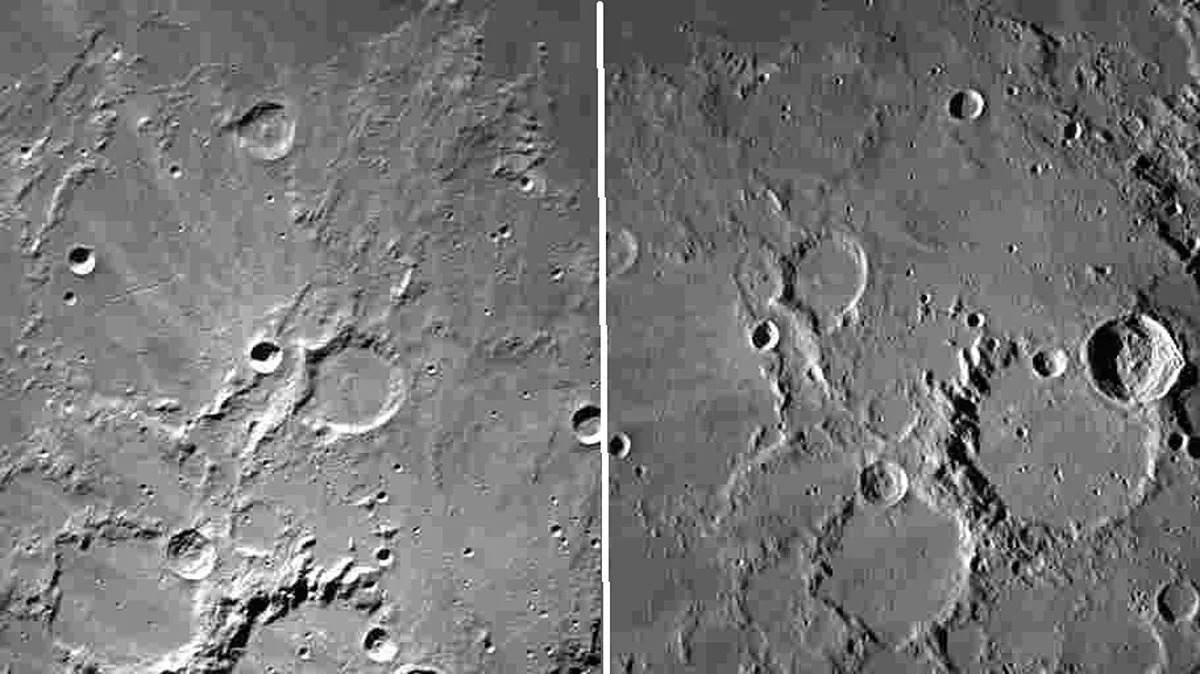
The first images of the moon and the lunar surface as seen by Jaxa's SLIM lander.
After arriving in orbit around the moon on Christmas Day, Japan's Smart Lander for Investigating Moon (SLIM) moon lander has beamed back its first images of the lunar surface.
The Japan Aerospace Exploration Agency (JAXA) revealed the monochrome but highly detailed images of the crater-pocketed moon surface on its X feed, formerly Twitter.
The images were created after the spacecraft was successfully inserted into lunar orbit at 2:51 a.m. EST (0951 GMT or 4:51 p.m. Japan time) on Monday (Dec. 25).
Related: Japan's SLIM 'moon sniper' lander arrives in lunar orbit for Christmas
"SLIM successfully completed main engine injection at 16:51 and successfully entered lunar orbit! Below is an image sent from SLIM near the moon," JAXA officials wrote.
SLIM launched on Sept. 6, along with JAXA's X-Ray Imaging and Spectroscopy Mission (XRISM). While XRISM remained in orbit around Earth, conducting its mission to investigate cosmic X-ray sources, SLIM left our planet for an elliptical orbit, circling the moon roughly once every 6.4 hours.
This orbit brings the lander as close to the lunar surface as around 373 miles (600 kilometers), with the spacecraft swinging out as far as 2,485 miles (4,000 km) from the moon.
The 8.8-foot-long (2.7 meters) spacecraft is set to touch down on the moon on Jan. 24. If SLIM's lunar landing is successful, it will make Japan the fifth country after the Soviet Union, the U.S., China, and India to make a lunar landing successfully.
Related Stories:
— Record-Holding Moon Mission Marks a Decade in Orbit
— Moon crash site found! NASA orbiter spots grave of private Japanese lander (photos)
— South Korean moon probe snaps picture of NASA's powerful lunar orbiter (photo)
After successfully setting down on the moon, SLIM will verify the technology needed for landings on the moon and also solar system planets, as well as conducting up close and personal investigations of the lunar surface with a small-scale probe, according to JAXA.
"By creating the SLIM lander, humans will make a qualitative shift towards being able to land where we want and not just where it is easy to land, as had been the case before," the space agency wrote in a mission description. "By achieving this, it will become possible to land on planets even more resource-scarce than the moon."
No comments:
Post a Comment